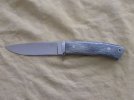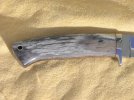That´s a lot of information, some have passionate opinions on the matter, others tend to be softer, but I think I kind of understand it better now, thank you all for your imputs. I will keep up the debate now directing it towards some points I would like to adress:
1) lots of you guys consider GB to be a fake substitute to fossil ivory. I have never seen it being sold that way, not in a knife and not by supliers. On the other hand the dyes and colours strongly sugest they try to copy the much more noble material, something that really bothers the most traditional collectors.
2) some people adress the fact it´s dyed bone, nothing more. Well 90% of the stag out there is also dyed in the most simple fashion: potasium permanganate or leather dye, etc. Yet it doesn´t get the same attention, mostly because those dyes bring the stag closer to what it should look like. Now some of the GB dyes are made in such bad taste, making it look SO bad, that I must agree to this in some extend. But on the other hand some have exactly the same efect that other dyes (maybe just a deeper effect) have over stag. To this point of view, some have expressed that dyes are not really an issue so I will stick to the bad taste hipotesys. Just to add some more wood to the fire... I have seen dyed fossil ivory as well. Looks much better than the GB, but it´s not as good as natural coloured fossil ivory.
3) cracks... now this is kind of new. I´ve never seen a major crack in GB but I just might haven´t seen too many knives with this material then. What we usualy see are superficial cracks caused by heat. They cook the bone to get those there and when the dye comes they show up and the bone looks old. Never seen one of those develop to a frecture but again... I just may haven´t seen enough so if you have news of this happening please throw them in here.
4) Nature of the animal... well since I have seen a fossil walrus penis used as a sword handle nothing more will shock me. Seriously I never thought that the nature of the animal would be such an important matter. I guess that, in that sense, the most important aspect was if the animal was rare or common and if the material looks good. Maybe I should pay more attention to that in the future.
5) it´s bone, simple bone... well.. it is, but in fact nobody ever tried to pass it as something else. As far as being bone, it´s much better than cow bone IMHO. I have seen other bones that look like crap and along with fossil whale bones, GB are the best... when talking about bones.
6) Price... I guess that we all agree tha it´s overpriced and the diference should not be so great that you would not chosse it for the real good fossil ivory. However in places like Brazil and other countries small diferences turn bigger due to currency exchange rates and that might be a problem sometimes cause some guys have to buy an year worth of supplies during the Blade Show and keep that money there.
My conclusion is that some people considers GB what it is: dyed bone, while others tend to take it as a fake attempt of something else. Both are right to some extend, and the responsability falls over the dyes choice to make it look like fossil ivory. Another thing is that, despite of the whole confusion of it´s definition, its darn pretty to most people. I myself like it, and do not mistake it for ivory... I really consider it something else. Maybe for commercial issues I might have to change my mind after all.
1) lots of you guys consider GB to be a fake substitute to fossil ivory. I have never seen it being sold that way, not in a knife and not by supliers. On the other hand the dyes and colours strongly sugest they try to copy the much more noble material, something that really bothers the most traditional collectors.
2) some people adress the fact it´s dyed bone, nothing more. Well 90% of the stag out there is also dyed in the most simple fashion: potasium permanganate or leather dye, etc. Yet it doesn´t get the same attention, mostly because those dyes bring the stag closer to what it should look like. Now some of the GB dyes are made in such bad taste, making it look SO bad, that I must agree to this in some extend. But on the other hand some have exactly the same efect that other dyes (maybe just a deeper effect) have over stag. To this point of view, some have expressed that dyes are not really an issue so I will stick to the bad taste hipotesys. Just to add some more wood to the fire... I have seen dyed fossil ivory as well. Looks much better than the GB, but it´s not as good as natural coloured fossil ivory.
3) cracks... now this is kind of new. I´ve never seen a major crack in GB but I just might haven´t seen too many knives with this material then. What we usualy see are superficial cracks caused by heat. They cook the bone to get those there and when the dye comes they show up and the bone looks old. Never seen one of those develop to a frecture but again... I just may haven´t seen enough so if you have news of this happening please throw them in here.
4) Nature of the animal... well since I have seen a fossil walrus penis used as a sword handle nothing more will shock me. Seriously I never thought that the nature of the animal would be such an important matter. I guess that, in that sense, the most important aspect was if the animal was rare or common and if the material looks good. Maybe I should pay more attention to that in the future.
5) it´s bone, simple bone... well.. it is, but in fact nobody ever tried to pass it as something else. As far as being bone, it´s much better than cow bone IMHO. I have seen other bones that look like crap and along with fossil whale bones, GB are the best... when talking about bones.
6) Price... I guess that we all agree tha it´s overpriced and the diference should not be so great that you would not chosse it for the real good fossil ivory. However in places like Brazil and other countries small diferences turn bigger due to currency exchange rates and that might be a problem sometimes cause some guys have to buy an year worth of supplies during the Blade Show and keep that money there.
My conclusion is that some people considers GB what it is: dyed bone, while others tend to take it as a fake attempt of something else. Both are right to some extend, and the responsability falls over the dyes choice to make it look like fossil ivory. Another thing is that, despite of the whole confusion of it´s definition, its darn pretty to most people. I myself like it, and do not mistake it for ivory... I really consider it something else. Maybe for commercial issues I might have to change my mind after all.





